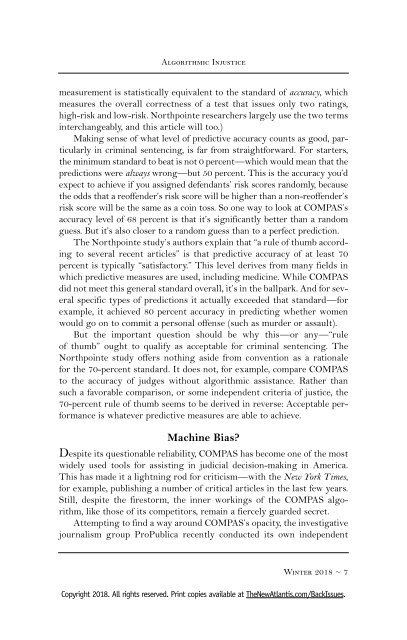The New Atlantis - Winter 2018 (Issue 54) uncompressed with cover
You also want an ePaper? Increase the reach of your titles
YUMPU automatically turns print PDFs into web optimized ePapers that Google loves.
Algorithmic Injustice<br />
measurement is statistically equivalent to the standard of accuracy, which<br />
measures the overall correctness of a test that issues only two ratings,<br />
high-risk and low-risk. Northpointe researchers largely use the two terms<br />
interchangeably, and this article will too.)<br />
Making sense of what level of predictive accuracy counts as good, particularly<br />
in criminal sentencing, is far from straightforward. For starters,<br />
the minimum standard to beat is not 0 percent — which would mean that the<br />
predictions were always wrong — but 50 percent. This is the accuracy you’d<br />
expect to achieve if you assigned defendants’ risk scores randomly, because<br />
the odds that a reoffender’s risk score will be higher than a non-reoffender’s<br />
risk score will be the same as a coin toss. So one way to look at COMPAS’s<br />
accuracy level of 68 percent is that it’s significantly better than a random<br />
guess. But it’s also closer to a random guess than to a perfect prediction.<br />
<strong>The</strong> Northpointe study’s authors explain that “a rule of thumb according<br />
to several recent articles” is that predictive accuracy of at least 70<br />
percent is typically “satisfactory.” This level derives from many fields in<br />
which predictive measures are used, including medicine. While COMPAS<br />
did not meet this general standard overall, it’s in the ballpark. And for several<br />
specific types of predictions it actually exceeded that standard — for<br />
example, it achieved 80 percent accuracy in predicting whether women<br />
would go on to commit a personal offense (such as murder or assault).<br />
But the important question should be why this — or any — “rule<br />
of thumb” ought to qualify as acceptable for criminal sentencing. <strong>The</strong><br />
Northpointe study offers nothing aside from convention as a rationale<br />
for the 70-percent standard. It does not, for example, compare COMPAS<br />
to the accuracy of judges <strong>with</strong>out algorithmic assistance. Rather than<br />
such a favorable comparison, or some independent criteria of justice, the<br />
70- percent rule of thumb seems to be derived in reverse: Acceptable performance<br />
is whatever predictive measures are able to achieve.<br />
Machine Bias?<br />
Despite its questionable reliability, COMPAS has become one of the most<br />
widely used tools for assisting in judicial decision-making in America.<br />
This has made it a lightning rod for criticism — <strong>with</strong> the <strong>New</strong> York Times,<br />
for example, publishing a number of critical articles in the last few years.<br />
Still, despite the firestorm, the inner workings of the COMPAS algorithm,<br />
like those of its competitors, remain a fiercely guarded secret.<br />
Attempting to find a way around COMPAS’s opacity, the investigative<br />
journalism group ProPublica recently conducted its own independent<br />
<strong>Winter</strong> <strong>2018</strong> ~ 7<br />
Copyright <strong>2018</strong>. All rights reserved. Print copies available at <strong>The</strong><strong>New</strong><strong>Atlantis</strong>.com/Back<strong>Issue</strong>s.


